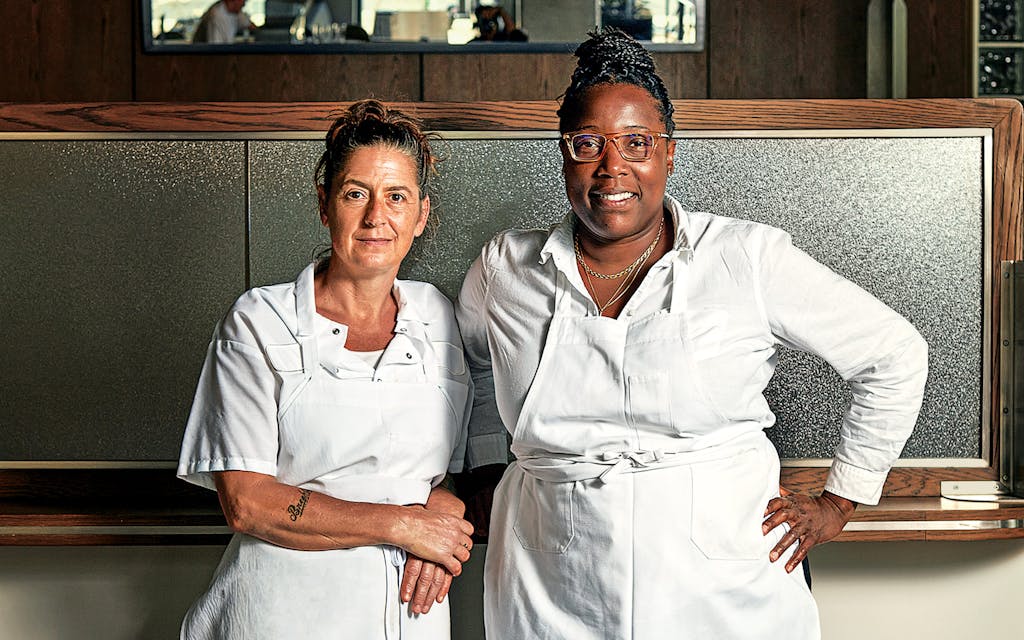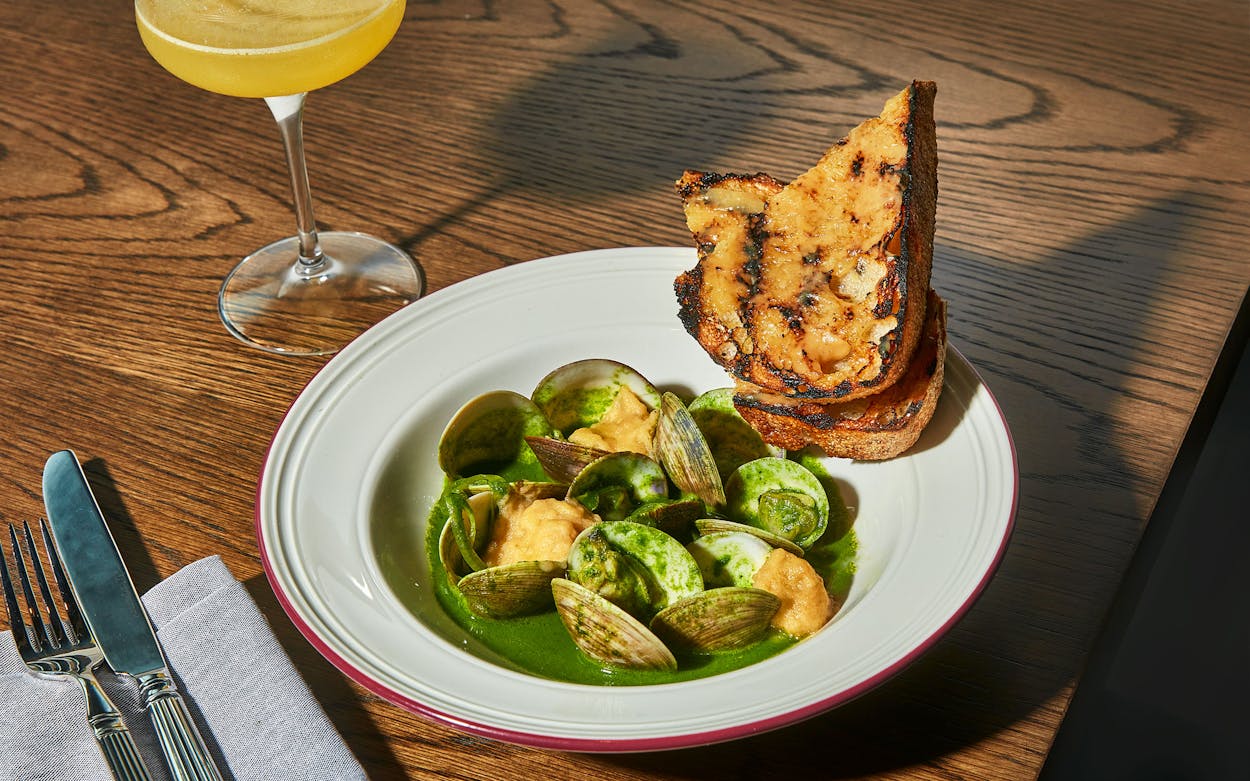If you are even moderately curious about food and dining, there’s a good chance you’ve heard of the Grey. Perhaps in 2019 you watched the evocative episode of Netflix’s Chef’s Table in which the Grey’s executive chef, Mashama Bailey, reminisces about “thrills”—the homemade ice pops of her childhood—and gamely dons waders to slosh through a muddy Georgia marsh and inspect a budding oyster crop.
The Savannah restaurant’s distinctive cuisine—melding influences from Africa, Europe, and the American South—had already been attracting national attention, and in the spring of that year, Bailey won the James Beard Award for Best Chef: Southeast. All of which is to say that 2019 was a very good year for the Grey. The four-year-old place was on such a roll that serious plans were being made to open a sister location in Austin. Bailey and John O. Morisano, her business partner and the restaurant’s deeply involved money man, had paid several visits to the Texas capital and determined that the city was a promising match. And then—as we know all too well—COVID-19 reared its ugly head.
For more than two years, the Grey’s expansion plans were on hold. But in January 2022, Bailey arrived in Texas to mother-hen the nascent operation alongside Austinite and chef de cuisine Kristine Kittrell, and three months later, finally, the restaurant opened in the new, upscale Thompson hotel downtown. Called the Diner Bar (named after the casual bar area of the Grey), it is not a replica of the beautifully renovated 1938 Greyhound bus terminal that houses the Savannah restaurant, but it captures the feeling.

On a recent spring evening, three friends and I found ourselves in a roomy booth, happily discussing choices. But once we saw the words “foie and grits” on the menu, we all agreed on our first course. In short order a pristine white bowl appeared in the hands of a chatty server (“I came from the Savannah location to help get things going, but I really like Austin, and now I think I might stay”). Arranged in the shallow vessel in precise concentric circles were, first, an almost meaty, auburn-hued “onion gravy”; then the palest ivory mound of Texas heirloom grits; and, last, the payoff: a gorgeously seared lobe of duck liver topped with a sweet dab of strawberry mostarda. I scooped a little of everything into one heavenly bite. “Oh, yeah,” I thought. “This is going to be a very good evening.”
Bailey is a chef who straddles worlds. A key part of her childhood was spent around Savannah, learning about cooking from female family members who knew their way around a vegetable garden. Later in her life, she would develop a deep admiration for the late Edna Lewis, the noted African American chef and author who insisted that Southern cooking is about far more than deep frying and championed seasonality decades before the term became a catchphrase. Ultimately settling on cooking as a career, Bailey got serious, graduating from what is now the Institute of Culinary Education, in New York, and then working at the École de Cuisine La Varenne, in Burgundy, with the très formidable Anne Willan. But the place where her skills were truly sharpened was Prune, in New York’s East Village, under the equally formidable Gabrielle Hamilton. (In a what-are-the-odds coincidence, when Morisano went looking for a chef for the Grey, one of the people he consulted was Hamilton. As it turned out, she happened to know someone who might work.)
All of these early influences have found their way onto the Diner Bar’s eclectic menu. Looking for dishes that drew on Bailey’s lauded
Southern repertoire, we tried a trio of hefty pink shrimp atop Carolina Gold rice in a light, vegetable-forward pot liquor, with the occasional green pea tendril peeking out. We liked the variant of crab Louie, a salad of picture-perfect lump crabmeat accessorized with the South’s sassy comeback sauce, a mix-and-match concoction of mayo, ketchup, Worcestershire, hot sauce, and whatever else the chef likes. A plump chicken-fried quail came with a sophisticated and surprising sauce: demi-glace spiked with espresso. Somehow, we also squeezed in the roast chicken, half a fowl so skillfully cooked that under its well-bronzed skin both the white and dark meat were moist.


On my next visit with another group of friends (who were very much hoping for a Bailey sighting and selfie opportunity), we were drawn to a radical updating of chicken and dumplings. The usual broth had been switched out for a light and liquid version of France’s pistou (part of the pesto family), rich with basil, tarragon, and a bit of jalapeño. In lieu of the usual bird we found clams in their shells and dense, chubby dumplings, golden and glistening. Continuing our Gallic theme, we tried the lovely lamb crepinettes, which reminded me a bit of individual meat loaves and came with a shoal of creamy mashed russet potatoes alongside. And, finally, against my better judgment, I ordered the kale and collard greens. They sounded so promising, punched up with onions, leeks, and shallots and treated to a gentle hour-long braise. My reaction will not sit well with greens’ gazillion fans, but I found them to be only a bit less tragically sad and murky than most greens. (And now, if you’ll excuse me, I have to go apply to the Witness Protection Program.)
On my final visit I went alone. The place is not far from my office, so on a whim I walked over at five o’clock and settled into a solitary seat at the bar. I wasn’t too hungry, so an unusual starter of berbere-spiced carrots and dates sounded perfect. In a bit, they arrived, the bottom layer mashed and a brilliant orange, the top layer whole, beautifully roasted, and resting on a bed of barley and farro verde seasoned with the heady, rust-colored Ethiopian mix of powdered chiles, garlic, fenugreek, coriander, cardamom, and more. The combination was savory, sweet, and sensational. Still a bit peckish, I rounded out my snack with ugali, a sort of African maize-flour custard that is a spiritual relative of polenta. Formed into rectangles, dusted with panko, and fried, it was, to my great surprise, served with Mexico’s salsa macha, the oil-based sauce rife with sesame seeds, nuts, and chile flecks. In a matter of minutes, I had finished the plateful.
On my way back to the office, I couldn’t help thinking how different these two dishes were from what I’d had before. Bailey has long incorporated disparate influences, but these seemed less tethered to the Southern repertoire. She had confirmed as much when we spoke a few days earlier, telling me that salsa macha was something she had tasted for the first time on a recent trip to Mexico: “I thought it was great. It had peanuts and sesame seeds, and I was like, ‘We could be in the South.’ ” She’s intrigued by symbiotic flavors, wherever they come from. As she had said when we wrapped up our chat, “I’m a Southern cook, but I’m not necessarily cooking Southern food. It’s a bit of a mishmash.” It was an offhand remark, but it seemed key to me. It’s easy to stress her Southern heritage, but much more is going on. Will the Diner Bar in Austin be a place where she pushes the boundaries of that worldly mishmash? I can’t wait to see.
Diner Bar
500 San Jacinto Blvd, Austin
737-257-3047
D 7 days.
$$$
Opened April 11, 2022
This article originally appeared in the July 2022 issue of Texas Monthly with the headline “The Bus Stops Here.” Subscribe today.
- More About:
- Pat’s Pick
- Restaurant Reviews
- Austin









